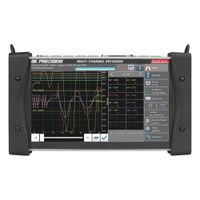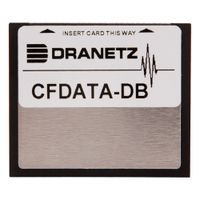Call +(254) 703 030 000 / 751 483 999 / 721 704 777
- Home
- Test Instruments
- Data Recording
- Nonelectrical Properties Data Loggers Accessories
.....Read More
Frequently Asked Questions
What are the key features to look for in a non-electrical data logger?
When selecting a non-electrical data logger, consider the following key features:
1. **Durability**: Ensure the data logger is made from robust materials to withstand environmental conditions such as temperature fluctuations, humidity, and physical impacts.
2. **Capacity**: Look for a data logger with sufficient storage capacity to record the required amount of data over the desired time period.
3. **Accuracy**: The data logger should provide precise measurements to ensure reliable data collection.
4. **Ease of Use**: It should be user-friendly, with clear instructions and easy setup procedures.
5. **Size and Portability**: A compact and lightweight design is beneficial for easy transportation and deployment in various locations.
6. **Data Retrieval**: Consider how data is extracted from the logger. It should have a straightforward method for data retrieval, whether through manual reading or other means.
7. **Environmental Resistance**: The logger should be resistant to environmental factors such as water, dust, and chemicals, depending on the application.
8. **Cost**: Evaluate the cost-effectiveness, ensuring it fits within budget constraints while meeting all necessary requirements.
9. **Maintenance**: Look for a logger that requires minimal maintenance to reduce downtime and operational costs.
10. **Compatibility**: Ensure it is compatible with any existing systems or processes for seamless integration.
11. **Brand Reputation**: Consider products from reputable brands known for quality and reliability.
12. **Warranty and Support**: Check for warranty options and the availability of customer support for troubleshooting and repairs.
By focusing on these features, you can select a non-electrical data logger that meets your specific needs and ensures efficient and reliable data collection.
How do non-electrical data loggers differ from electrical data loggers?
Non-electrical data loggers and electrical data loggers differ primarily in their power sources, data recording methods, and applications.
Non-electrical data loggers, often mechanical or chemical, do not rely on electricity to function. They typically use physical or chemical changes to record data. For example, a mechanical chart recorder might use a pen and rotating drum to log temperature changes over time, while a chemical data logger might use color changes in a strip to indicate exposure to certain conditions. These loggers are often used in environments where electrical power is unavailable or impractical, such as remote locations or hazardous environments. They are generally simpler, more robust, and less susceptible to electronic interference, but they may offer less precision and data storage capacity compared to their electrical counterparts.
Electrical data loggers, on the other hand, use electronic sensors and digital storage to record data. They are powered by batteries or external power sources and can log a wide range of parameters, including temperature, humidity, pressure, and more. These loggers often feature digital displays, programmable settings, and the ability to store large amounts of data, which can be easily transferred to computers for analysis. They are widely used in scientific research, industrial monitoring, and environmental studies due to their accuracy, versatility, and ease of data retrieval.
In summary, non-electrical data loggers are typically more durable and suitable for specific environments where electricity is a constraint, while electrical data loggers offer greater precision, versatility, and data management capabilities, making them suitable for a broader range of applications.
What are the common applications of non-electrical data loggers?
Non-electrical data loggers are devices used to record data over time without relying on electrical power sources. They are commonly used in various fields for monitoring and analysis purposes. Here are some common applications:
1. **Temperature Monitoring**: Non-electrical data loggers are often used in environments where electronic devices might fail due to extreme temperatures. They are used in cold chain logistics to ensure that perishable goods like food and pharmaceuticals are kept within safe temperature ranges during transportation and storage.
2. **Humidity Tracking**: In museums and archives, non-electrical data loggers help monitor humidity levels to protect sensitive artifacts and documents from damage due to moisture.
3. **Pressure Measurement**: These loggers are used in industrial settings to monitor pressure levels in pipelines and storage tanks, ensuring safety and compliance with regulations.
4. **Environmental Studies**: Researchers use non-electrical data loggers to collect data in remote or harsh environments, such as monitoring wildlife habitats, studying climate change, or tracking weather patterns.
5. **Agriculture**: Farmers use these devices to monitor soil conditions, such as moisture levels and temperature, to optimize crop production and manage irrigation systems effectively.
6. **Transportation**: In the shipping industry, non-electrical data loggers are used to track the conditions of cargo, ensuring that goods are transported under optimal conditions.
7. **Construction**: These loggers are used to monitor structural integrity by measuring parameters like stress and strain in building materials over time.
8. **Water Quality Monitoring**: Non-electrical data loggers are employed to track parameters such as pH, turbidity, and temperature in bodies of water, aiding in environmental protection and compliance with water quality standards.
These applications highlight the versatility and importance of non-electrical data loggers in various sectors, providing reliable data collection in situations where electronic devices may not be feasible.
How do you maintain and calibrate non-electrical data loggers?
To maintain and calibrate non-electrical data loggers, follow these steps:
1. **Regular Inspection**: Periodically inspect the data logger for any physical damage or wear. Check seals, housings, and any mechanical components to ensure they are intact and functioning properly.
2. **Cleaning**: Clean the data logger using appropriate methods and materials. Avoid harsh chemicals that could damage the device. Use a soft cloth and mild detergent if necessary.
3. **Battery Check**: If the data logger uses a battery, ensure it is charged or replaced regularly. For non-electrical loggers, ensure any mechanical power sources are functioning.
4. **Calibration**:
- **Reference Standards**: Use traceable reference standards to calibrate the data logger. These standards should be more accurate than the data logger itself.
- **Calibration Procedure**: Follow the manufacturer’s recommended calibration procedure. This often involves comparing the logger’s readings with the reference standard under controlled conditions.
- **Adjustment**: If discrepancies are found, adjust the data logger according to the manufacturer’s instructions to align with the reference standard.
- **Documentation**: Record all calibration activities, including date, reference standards used, and any adjustments made.
5. **Environmental Conditions**: Ensure the data logger is used within its specified environmental conditions. Extreme temperatures, humidity, or pressure can affect accuracy and longevity.
6. **Storage**: Store the data logger in a clean, dry place when not in use. Protect it from dust, moisture, and physical damage.
7. **Software Updates**: If applicable, ensure any associated software is up-to-date to maintain compatibility and functionality.
8. **Training**: Ensure personnel handling the data logger are trained in its operation, maintenance, and calibration procedures.
By following these steps, you can ensure the accuracy and reliability of non-electrical data loggers.
What types of sensors are compatible with non-electrical data loggers?
Non-electrical data loggers are designed to record data without relying on electrical power sources. They are typically mechanical or chemical in nature and can be used in environments where electronic devices might fail or be impractical. The types of sensors compatible with non-electrical data loggers include:
1. **Bimetallic Sensors**: These sensors use two metals with different expansion rates bonded together. As temperature changes, the metals expand or contract at different rates, causing the bimetallic strip to bend. This mechanical movement can be recorded on a chart or dial.
2. **Liquid-in-Glass Thermometers**: These traditional thermometers use the expansion and contraction of a liquid (like mercury or alcohol) in a glass tube to measure temperature. The movement of the liquid can be recorded on a scale.
3. **Pressure Gauges**: Mechanical pressure gauges use a Bourdon tube, diaphragm, or bellows to measure pressure changes. The deformation of these elements due to pressure changes can be mechanically linked to a recording device.
4. **Anemometers**: Mechanical anemometers, such as cup or vane types, measure wind speed through the rotation of cups or vanes. The rotation can be linked to a mechanical counter or chart recorder.
5. **Hygrometers**: Mechanical hygrometers often use materials like human hair or animal gut, which change length with humidity. This change can be mechanically amplified and recorded.
6. **Barographs**: These devices use an aneroid barometer mechanism to measure atmospheric pressure changes. The mechanical movement is recorded on a rotating drum covered with paper.
7. **Tide Gauges**: Float-operated tide gauges use a float in a stilling well to measure water level changes. The float's movement is mechanically linked to a recording device.
These sensors rely on physical changes in materials or mechanical movements to record data, making them suitable for environments where electronic sensors might not be feasible.
How do chartless digital recorders store and organize data?
Chartless digital recorders store and organize data using digital storage media and advanced data management systems. These devices capture input signals from various sensors and convert them into digital data using analog-to-digital converters. The digital data is then stored in internal memory, such as flash memory or hard drives, which allows for large volumes of data to be saved without the need for physical charts.
Data organization is managed through software that categorizes and indexes the information based on parameters like time, date, and type of measurement. This software often includes features for data compression to optimize storage space and ensure efficient retrieval. The data is typically stored in a structured format, such as databases or proprietary file systems, which allows for easy access and analysis.
Users can interact with the stored data through user interfaces, often provided via touchscreens or computer software, which allow for real-time monitoring and historical data review. The software may offer visualization tools, such as graphs and charts, to help users interpret the data effectively. Additionally, data can be exported in various formats, such as CSV or PDF, for further analysis or reporting.
To ensure data integrity and security, chartless digital recorders often include features like data encryption, user authentication, and audit trails. These measures protect the data from unauthorized access and ensure compliance with industry standards and regulations.
Overall, chartless digital recorders provide a flexible and efficient way to store and organize data, offering significant advantages over traditional chart recorders in terms of storage capacity, data accessibility, and ease of use.
What accessories are essential for operating and maintaining non-electrical data loggers?
1. **Protective Cases**: To safeguard the data logger from environmental factors such as dust, moisture, and physical damage.
2. **Mounting Brackets**: Essential for securely placing the data logger in the desired location, ensuring accurate data collection.
3. **Calibration Tools**: Necessary for maintaining the accuracy of the data logger. These tools help in adjusting the logger to ensure it provides precise readings.
4. **Replacement Parts**: Spare parts like sensors, gaskets, or seals are crucial for maintenance and quick repairs, minimizing downtime.
5. **Manuals and Documentation**: Comprehensive guides and manuals are essential for understanding the operation, troubleshooting, and maintenance procedures.
6. **Cleaning Supplies**: Regular cleaning is necessary to maintain the functionality and longevity of the data logger. This includes brushes, cloths, and appropriate cleaning solutions.
7. **Desiccants**: Used to control humidity levels within the data logger’s enclosure, preventing moisture-related issues.
8. **Security Locks**: To prevent unauthorized access or tampering with the data logger, especially in unsecured or public areas.
9. **Data Sheets and Logs**: For recording and tracking data manually, ensuring there is a backup in case of data loss.
10. **Storage Containers**: For organized storage of the data logger and its accessories when not in use, protecting them from damage.
11. **Labeling Tools**: For marking and identifying different data loggers, especially when multiple units are in use.
12. **Transport Cases**: Durable cases for safely transporting data loggers to different locations without damage.
13. **Weather Shields**: To protect the data logger from extreme weather conditions if used outdoors.
14. **Tool Kits**: Basic tools for assembling, disassembling, and performing minor repairs on the data logger.



